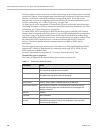
Polycom® RealPresence Collaboration Server (RMX) 1500/2000/4000 Administrator’s Guide
7-10 Polycom, Inc.
IVR media files, WAV for voice messages and JPG for video slides, are stored on the
application server. In order to provide external IVR control, a TCP-based MCCF channel is
created between the application server and the media server. Because of real-time
considerations, when the MCCF channel is established, the application server notifies the
media server about the media files. The media server downloads the media files. The media
server is notified by the application server when to download new or updated media files.
When the call has completed the pre-conference phase in the external IVR-controlled Entry
Queue, the application server disconnects the call from the Entry Queue and routes the call
to an ongoing conference or creates a new VMR.
Guidelines
• AVC SIP and TIP protocols are supported in the RealPresence Collaboration Server
1500/2000/4000 only.
• MCCF channels support both IPV4 and IPV6.
• When the MCCF channel is disconnected, an alarm is displayed and all external IVR
files are deleted. When the MCCF channel is reconnected, the external IVR files are sent
to the MCU.
• When the Collaboration Server (MCU) is restarted, all existing external IVR files are
deleted. When the MCCF channel connects to the Collaboration Server, the external IVR
file are sent to the Collaboration Server.
• H.323 and ISDN protocols are not supported.
• Video Switching conferences do not support the TIP protocol
• TIP-based conferencing does not support the following features during conferences:
— Gathering phase
— Skin display
— Text messaging using Message Overlay
— Site Name display
— PCM
— Click&View
• To play audio messages and display the welcome slide during the participant
connection to the conference via the Virtual Entry Queue, the Media files have to meet
the following requirements (as defined in the Entry Queue IVR Service):
— Audio messages: WAV files - PCM, 16 KHz, 16 bit, Mono
— Video slides: JPG files - 1920 x 1088 resolution
Configuring the Entry Queue for External IVR Services
The Entry Queue can be configured to place a call in the external IVR-controlled Entry
Queue.
To configure the Entry Queue for External IVR Services:
1 In the RMX Management pane, click Entry Queues.
2 In the Entry Queues pane, click the New Entry Queue icon.
The New Entry Queue dialog box is displayed.
3 In the Display Name field, type an appropriate display name for the Entry Queue.


















